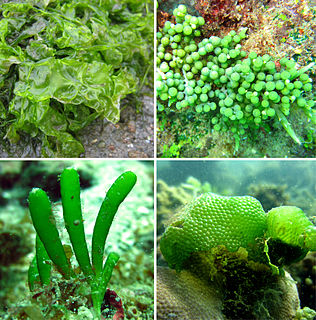
The Ulvophyceae or ulvophytes are a class of green algae, distinguished mainly on the basis of ultrastructural morphology, life cycle and molecular phylogenetic data. The sea lettuce, Ulva, belongs here. Other well-known members include Caulerpa, Codium, Acetabularia, Cladophora, Trentepohlia and Monostroma.
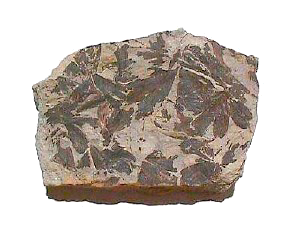
The Ginkgoaceae is a family of gymnosperms which appeared during the Mesozoic Era, of which the only extant representative is Ginkgo biloba, which is for this reason sometimes regarded as a living fossil. Formerly, however, there were several other genera, and forests of ginkgo existed. Because leaves can take such diverse forms within a single species, these are a poor measure of diversity, although differing structures of wood point to the existence of diverse ginkgo forests in ancient times.

Anseranatidae, the magpie-geese, is a biological family of waterbirds. The only living species, the magpie goose, is a resident breeder in northern Australia and in southern New Guinea.

Xenacanthida is an order of prehistoric sharks that appeared during the Lower Carboniferous period. The order includes the families Xenacanthidae, Diplodoselachidae, and Orthacanthidae. The most notable members of the group are the genera Xenacanthus and Orthacanthus. Some Xenacanthida may have grown to lengths of 5 m (16 ft). Most forms had large serrated spines extending backwards from the neck. Xenacanthus had characteristic teeth. Most xenacanths died out at the end of the Permian in the Permian Mass Extinction, with only a few forms surviving into the Triassic period. They were native to freshwater, marginal marine and shallow marine habitats.
Zapalasaurus is a genus of sauropod dinosaur described by Leonardo Salgado, Ismar de Souza Carvalho and Alberto Garrido in 2006. It was named after the city of Zapala, which is approximately 80 kilometres (50 mi) away from where the holotype was discovered. The type species, Zapalasaurus bonapartei, was found in the La Amarga Formation of the Neuquén Basin, Neuquén Province, Argentina. It was a diplodocoid, a long-necked herbivore, and it lived during the Early Cretaceous. The authors conclude from examining the skeleton that "The record of Zapalasaurus bonapartei shows that, at least in the Neuquén Basin, basal diplodocoids were more diverse than previously thought." Zapalasaurus is assumed to have a long neck which would have been developed for feeding adaption, allowing its neck to swing in an arc like shape. This would allow Zapalasaurus to browse a wide variety of plants and greens without having to walk very far.
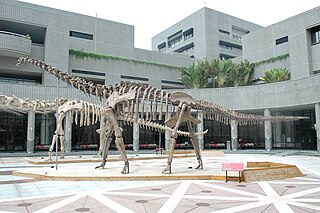
Huanghetitan, is a genus of sauropod dinosaur from the early Cretaceous Period. It was a basal titanosauriform which lived in what is now Gansu, China.

Cladophorales are an order of green algae, in the class Ulvophyceae.

Macrodelphinus is an extinct genus of primitive odontocete known from Late Oligocene (Chattian) marine deposits in California.

Créchy is a commune in the Allier department in central France.
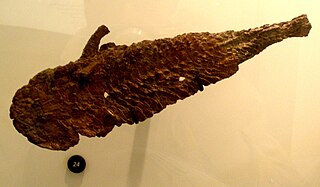
The Megalichthyidae are a family of prehistoric lobe-finned fishes which lived from the late Devonian to the early Permian period.
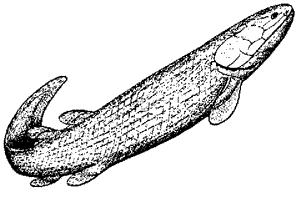
Ectosteorhachis is a genus of prehistoric lobe-finned fish that lived during the Permian period. It belonged to the group of Tetrapodomorpha and to the family of Megalichthyidae. Ectosteorhachis was a fresh water fish.
Vinceria is an extinct genus of kannemeyeriiform dicynodont in the family Shansiodontidae. Fossils of the genus have been found in the Anisian Cerro de las Cabras Formation and Carnian Río Seco de la Quebrada Formation of Argentina. One species, C. argentinensis, named in 1966, was moved to its own genus, Acratophorus, in 2021. Another species, V. vieja, was merged with Acratophorus argentinensis in 2021, leaving V. andina as the only species in the genus.
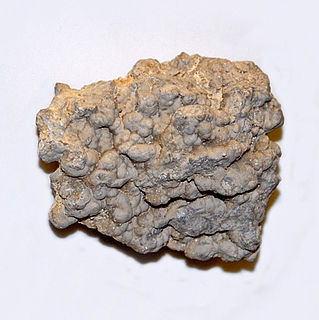
The extinct Solenoporaceae have traditionally been interpreted as a group of red algae ancestral to the Corallinales.
Meiconodon is an extinct genus of alticonodontine triconodontid which existed in China during the early Cretaceous period. It was described by Nao Kusuhashi, Yaoming Hu, Yuanqing Wang, Satoshi Hirasawa and Hiroshige Matsuoka in 2009 and the type species is Meiconodon lii.
Pascualgnathus is an extinct genus of traversodontid cynodonts from the Middle Triassic of Argentina. Fossils have been found from the Río Seco de la Quebrada Formation of the Puesto Viejo Group. The type species P. polanskii was named in 1966.
Nogodinidae is a family of planthoppers. They have membranous wings with delicate venation and can be confused with members of other Fulgoroid families such as the Issidae and Tropiduchidae. Some authors treat it as a subfamily of the Issidae. Some of their key features are a frons ("face") that is longer than wide and a reticulate wing venation. They are less than 2 cm long. The antenna arises well below the eye, has the base clubbed and flagellum unsegmented. The lateral ocelli are outside the margins of the face. The face has carinae on the edge. On the hind leg, the second tarsal segment has an apical spine arising from it. The tibia of the hind leg also has spines towards the tip. An important family character is found in the shape of the male genital structure, a style that is longer than broad. Most members of this family are forest species.
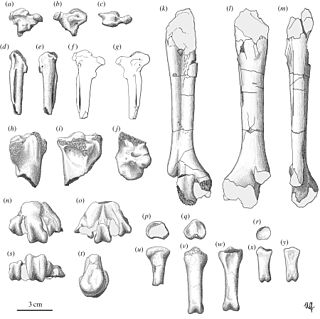
Garganornis is an extinct genus of enormous flightless anatid waterfowl from the Late Miocene of Gargano, Italy. The genus contains one species, G. ballmanni, named by Meijer in 2014. Its enormous size is thought to have been an adaptation to living in exposed, open areas with no terrestrial predators, and as a deterrent to the indigenous aerial predators like the eagle Garganoaetus and the giant barn owl Tyto gigantea.

Sinamiidae is an extinct family of ray-finned fish. They are halecomorph fishes endemic to Early Cretaceous freshwater environments in eastern Asia.

Acratophorus is an extinct genus of dicynodont that lived during the Anisian age of the Middle Triassic-aged Río Seco de la Quebrada Formation in what is now Argentina. The type species, A. argentinensis, was originally placed in the genus Kannemeyeria by Jose Bonaparte in 1966, and later sometimes referred to Vinceria, before being transferred to a new, distinct genus, Acratophorus, in 2021 by Christian Kammerer and Angi Ordoñez. The species Vinceria vieja was also made a synonym of A. argentinensis in 2021. The holotype is PVL 3645, a partial skeleton discovered near a farm house in Puesto Viejo.

Caloneurodea is an extinct order of polyneopteran neopteran insects in the superorder Orthopterida. The Caloneurodea are known from fossils found in North America, Europe, Russia, and Asia and had a palegeographic range confined to Laurussia.


















